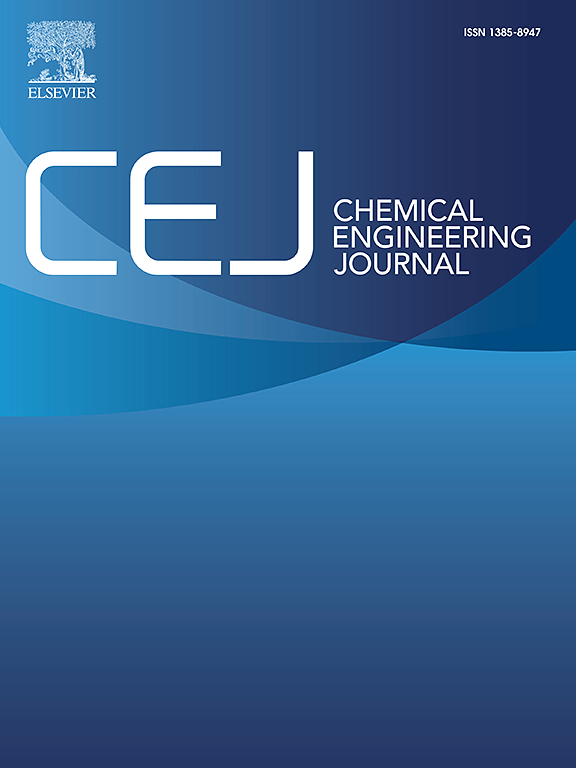Rapidsynthesis of an antifreeze and photocatalytic antibacterial multifunctional hydrogel for low-temperature preservation of marine fish
IF 13.2
1区 工程技术
Q1 ENGINEERING, CHEMICAL
引用次数: 0
Abstract
Globally, billions of tons of food are lost or wasted annually due to microbial contamination. Hydrogels are a new type of fresh-keeping material because of their porous three-dimensional network structure, offering enhanced loading capacity. However, traditional hydrogel packaging materials often suffer from limitations such as poor frost resistance, lack of catalytic antibacterial activity, and low factory application rate. In this study, firstly, carbon dots (CPCDs) catalyzing oxygen under visible light irradiation with broad-spectrum antibacterial activity (The minimum photocatalytic antibacterial concentration of H. alvei and P. fluorescens was 62.5 μg/ml) were synthesized. A hydrogel was rapidly formed using polyvinyl alcohol (PVA) and gelatin within 14 min of one-time freezing at −20 °C through hydrogen bonds, and excellent photocatalytic antibacterial activity and timely preservation were achieved by loading CPCDs. The low swelling (3.0) of the hydrogel and a release rate of <20% reduced the loss of CPCDs, thereby achieving a sustained antibacterial effect. Additionally, In the DSC experiment, no significant peak was observed between −80 °C and − 20 °C. The hydrogel was not crystallized and maintained its flexibility, which proved that the hydrogel had good frost resistance. The hydrogel could be completely peeled off from the surface of the Oncorhynchus mykiss fillet with a force of <0.5 N without any residue. The hydrogel showed no significant cytotoxicity and could extend the shelf life of O. mykiss fillet by >3 days. These findings underscored the potential of the developed hydrogels as efficient materials for the rapid preservation of frozen seafood.

海鱼低温保鲜用防冻光催化抗菌多功能水凝胶的快速合成
在全球范围内,每年有数十亿吨食物因微生物污染而损失或浪费。水凝胶是一种新型的保鲜材料,由于其多孔的三维网络结构,提供了增强的负载能力。然而,传统的水凝胶包装材料往往存在抗冻性差、缺乏催化抗菌活性、工厂应用率低等局限性。本研究首先合成了具有广谱抗菌活性的可见光下催化氧的碳点(CPCDs)(肺泡芽孢杆菌和荧光杆菌的最低光催化抗菌浓度为62.5 μg/ml)。聚乙烯醇(PVA)和明胶通过氢键在- 20 °C一次性冷冻14 min内快速形成水凝胶,并通过加载cpcd获得了良好的光催化抗菌活性和及时保存。水凝胶的低溶胀率(3.0)和20%的释放率减少了cpcd的损失,从而达到持续的抗菌效果。此外,在DSC实验中,在- 80 °C和 - 20 °C之间没有观察到明显的峰值。水凝胶不结晶,并保持其柔韧性,证明水凝胶具有良好的抗冻性。用<;0.5 N的力可将水凝胶从Oncorhynchus mykiss鱼片表面完全剥离而无任何残留物。该水凝胶无明显的细胞毒性,可使鱼片的保质期延长3 天。这些发现强调了开发的水凝胶作为快速保存冷冻海鲜的有效材料的潜力。
本文章由计算机程序翻译,如有差异,请以英文原文为准。
求助全文
约1分钟内获得全文
求助全文
来源期刊

Chemical Engineering Journal
工程技术-工程:化工
CiteScore
21.70
自引率
9.30%
发文量
6781
审稿时长
2.4 months
期刊介绍:
The Chemical Engineering Journal is an international research journal that invites contributions of original and novel fundamental research. It aims to provide an international platform for presenting original fundamental research, interpretative reviews, and discussions on new developments in chemical engineering. The journal welcomes papers that describe novel theory and its practical application, as well as those that demonstrate the transfer of techniques from other disciplines. It also welcomes reports on carefully conducted experimental work that is soundly interpreted. The main focus of the journal is on original and rigorous research results that have broad significance. The Catalysis section within the Chemical Engineering Journal focuses specifically on Experimental and Theoretical studies in the fields of heterogeneous catalysis, molecular catalysis, and biocatalysis. These studies have industrial impact on various sectors such as chemicals, energy, materials, foods, healthcare, and environmental protection.
 求助内容:
求助内容: 应助结果提醒方式:
应助结果提醒方式:


